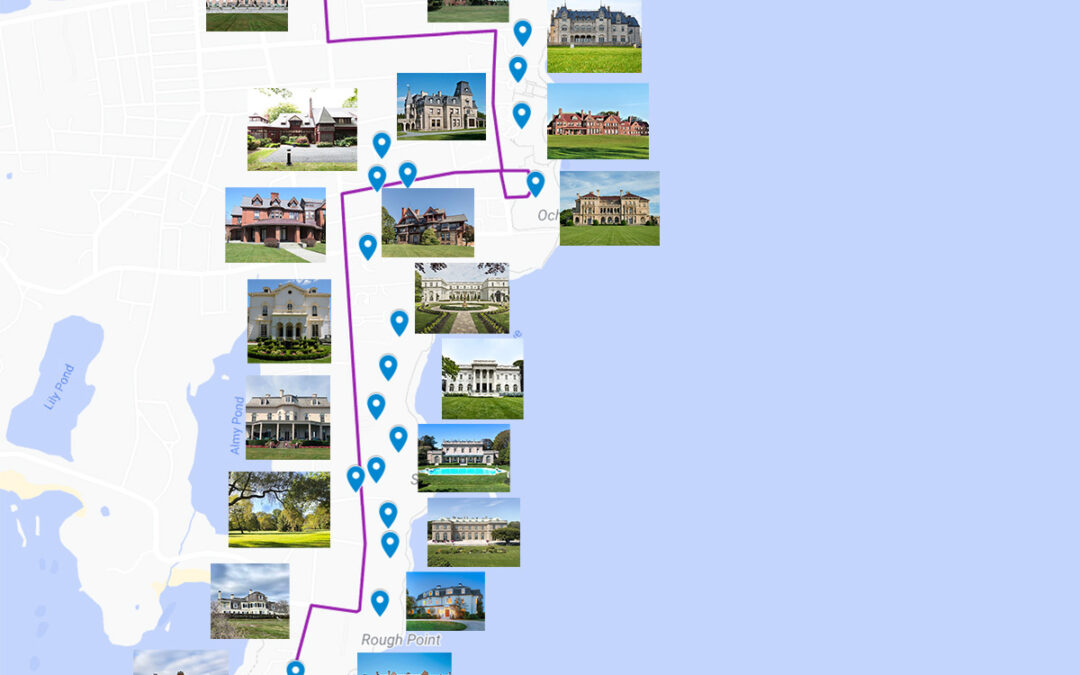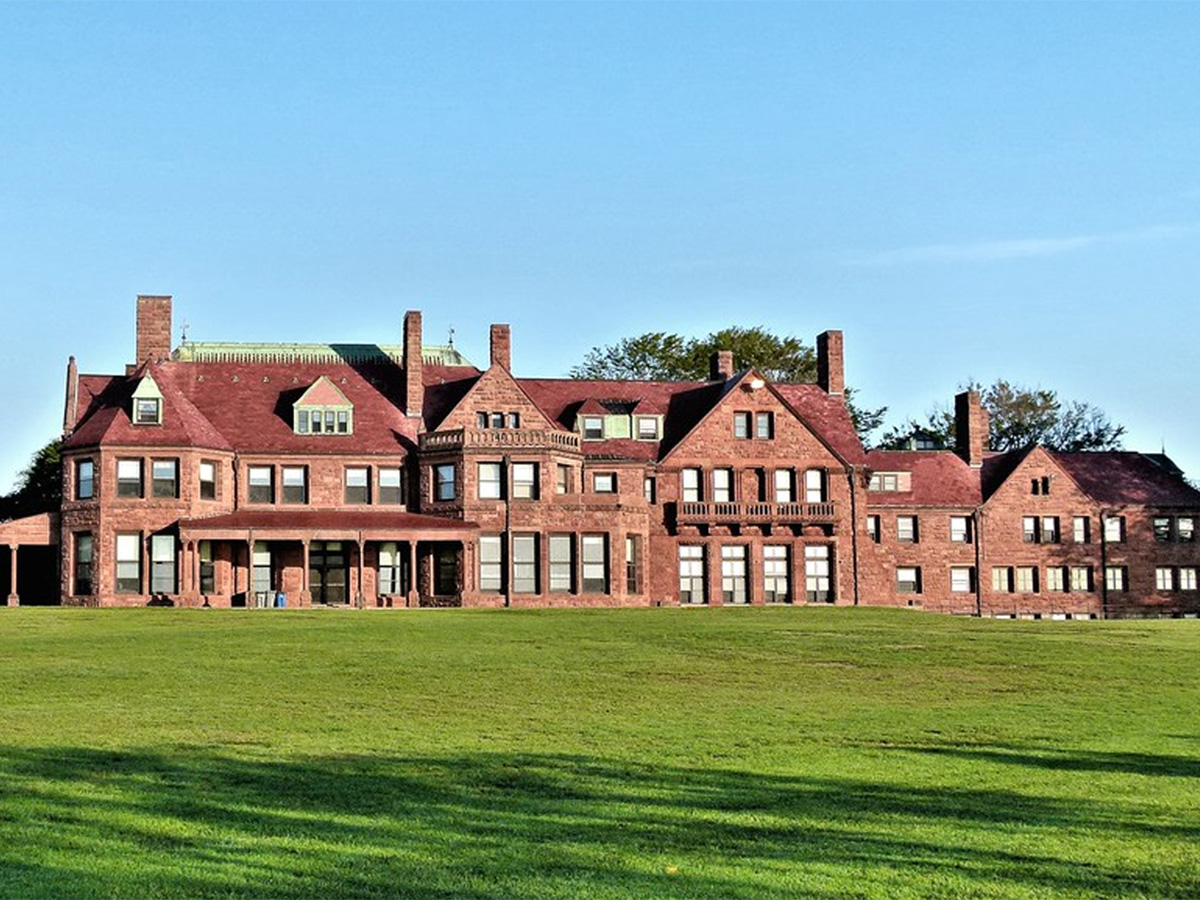The Newport Architecture Tour Map
Following the arrival of Caroline Astor (Mrs. William Backhouse When Astor Jr.) to Newport in 1880 things started to change rapidly. What had been a quiet and gentile summer retreat for old money people from New York, Boston, Philadelphia, and elsewhere suddenly became a supercharged center of social attention.
Mrs. Astor is famous for being the origin of the term “The 400” as that was the number of people who could fit into her New York mansion’s ballroom at Christmas and so, in the late 19th century New York, your place on the social pecking order was established by whether you were on her guest list or not.
When she purchased Beechwood in 1880, New York society followed en masse and a building boom of large and palatial summer cottages began in earnest. The comfortable but informal Queen Anne Revival and Shingle Style homes of the early Gilded Age were no longer what the well-heeled summer residents wanted for their architects.
Even McKim Mead & White, who were the originators of the Shingle Style just a few years earlier, were abandoning this relaxed and original wooden architecture for high symmetrical and derivative masonry palace like Rosecliff (1901). The buildings were made to look like they had been magically transported from Europe to Newport and were intended to convey the aura of American royalty upon the owners of these grand structures.
Many of these extraordinary structures were built in the Ochre Point neighborhood. In 1872, when many mansions began to be constructed, the tax on the first $ 1 million of income was 25%. By the conclusion of World War I. In 1917, the tax on the $1 million had risen to 65%. This had two large impacts: it greatly diminished the discretionary income of the very highest income earners, and it greatly expanded the opportunities for the people who had formerly been in service in the house, and therefore these large houses became impossibly expansive and unmanageable as homes at the same time.
During much of the 20th century, the owners of these once-grand homes struggled to figure out how to maintain them. Some turned them into schools, others were converted to condominiums or apartments, and others were destroyed by fire or demolished to remove them from the tax rolls.
In the Ochre Point neighborhood of Newport, starting with the gift of Ochre Court to the sisters of Mercy to fund Salve Regina University in 1945, many were donated to or purchased by the University at a very low prices over time.
The Preservation Society acquired the Breakers from heirs of the Vanderbilt family and now operates as a house museum with over 400,000 visitors paying to see its extraordinary and grand interiors each year.
The grand High Gilded Age homes of the Ochre Point neighborhood are now icons of adaptive reuse and have become an important part of the foundation of the Newport tourist and University economy and infrastructure.
Here is a compact architectural tour with brief descriptions and histories of the various buildings to help visitors and residents alike better know and appreciate these Bellevue Avenue treasures.
BELLEVUE AVENUE WALKING ROUTE PART 1 (20 min)
26 – The Elms (Edward Juluis Berwind House)
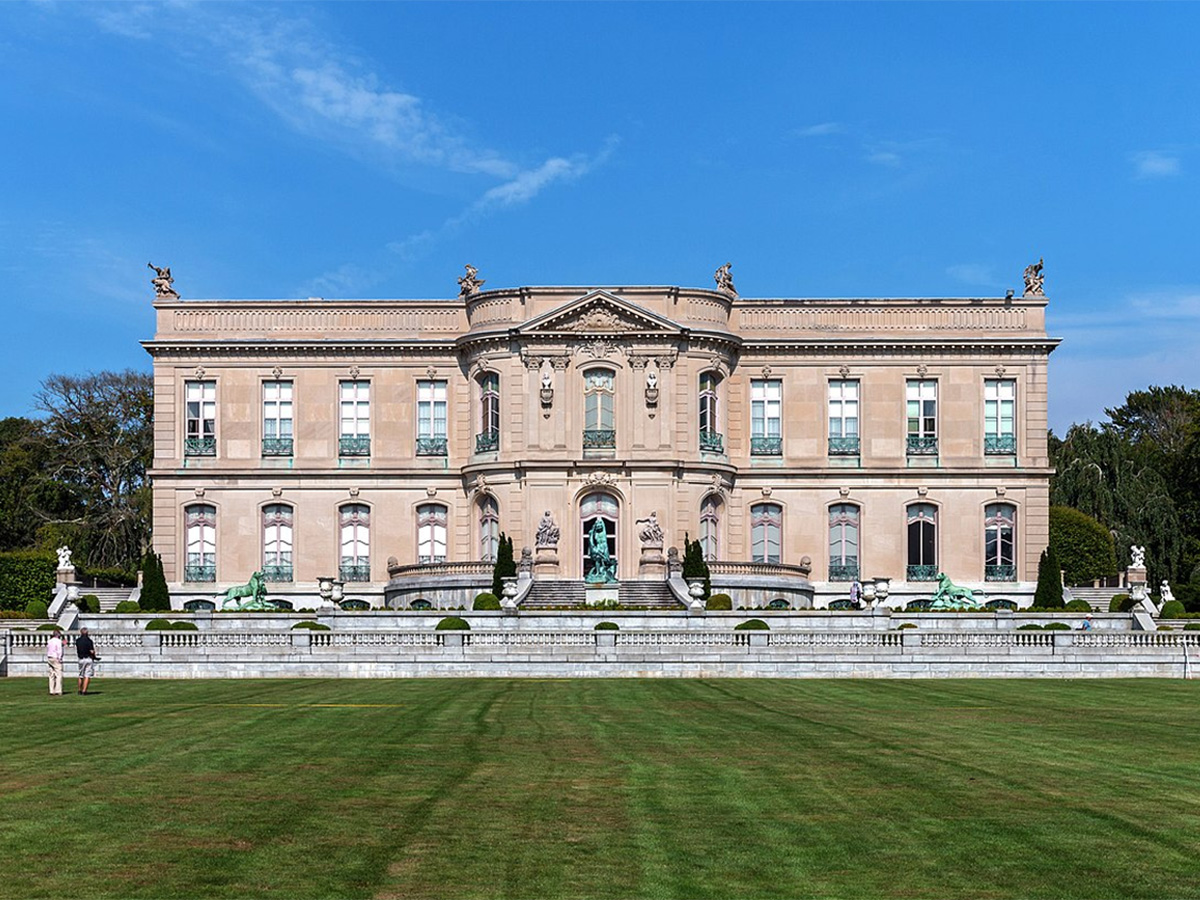
The Elms (Edward Juluis Berwind House) (Horace Trumbauer, 1899-1902)
- Mansion design by Philadelphia architect Horace Trumbauer for coal magnate Edward Berwind.
- Modeled after an 18th-century French chateau but featured the latest technology of the Gilded Age. It houses an outstanding collection of paintings, statuary and tapestries, and its landscape features formal gardens, terraces, pavilions, and fountains.
- The house was built with non-combustible materials: the house was built around a structural steel frame; the interior partitions, plaster over terra cotta blocks, sit on reinforced concrete floor slabs; the exterior walls are made of brick masonry and clad with limestone.
- On the main floor, the principal axis leads from the eastern entrance porch, into an entrance hall with a grand staircase and a marble floor, then into the ballroom, and then out to the garden beyond. The wing to the south contains a dining room, breakfast room, and serving pantry (the kitchens were in the basement), while the wing to the north contains a drawing room, library, and conservatory.
- H. Miller and E. W. Bowditch, working closely with Trumbauer, designed the gardens and landscape. They were designed in French eighteenth-century taste and include a sunken garden made from three earlier, smaller cottage plots.
The Elms was added to the National Register of Historic Places in 1971 and designated a National Historic Landmark on June 19th, 1996.
27 – Ochre Point
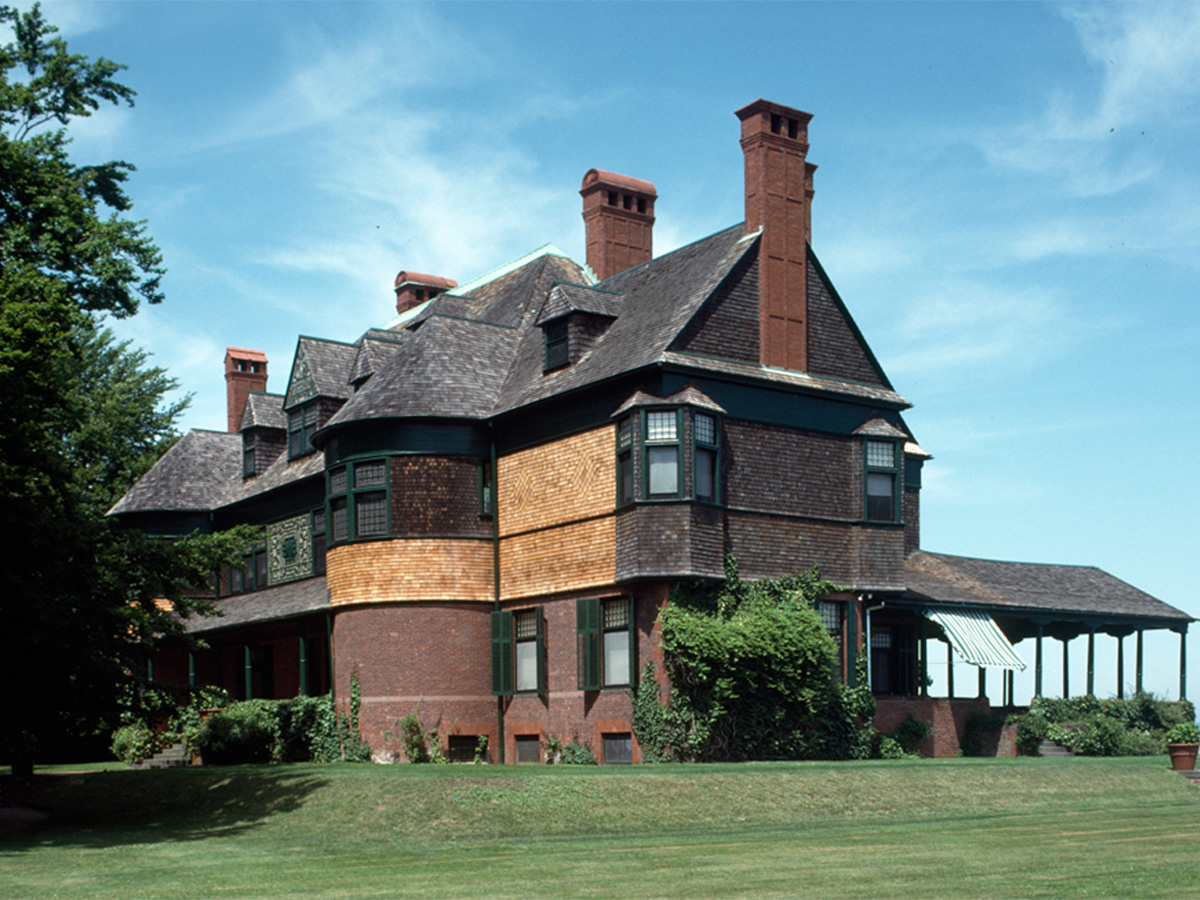
Ochre Point (Robert Goelet House) (McKim, Mead & White, 1881-1882)
- Generally known as “Southside”, until being renamed and referred to as “Ochre Point” later by the original owner’s daughter in law Anne because it is “not south of anything “.
- It was rare back then to see a shingle style house of such size, expensive and on cliff walk. This was the largest and most elaborate of the firm’s new “rustic cottages” at the time.
- The house purposefully presented two fronts: a formal side facing the street, and a less formal side overlooking the ocean. It can present the image of a simple, seaside home, but its scale and grandeur is immediately apparent on entering the oak-paneled hall draped in tapestries.
- Southside is one of the Gilded Age estates that is still owned by the same family that originally commissioned it.
Next door to the eventual home built by his younger brother years later.
28 – Ochre Court
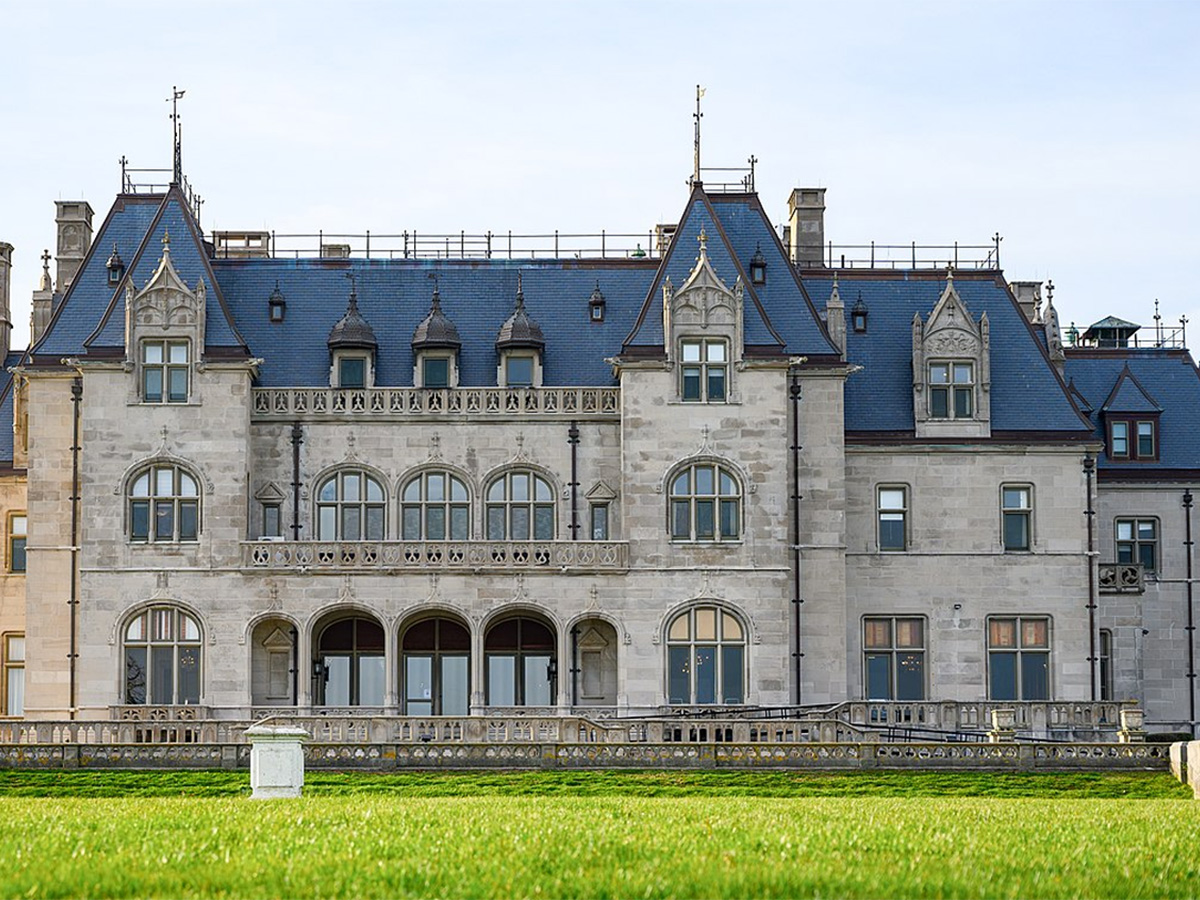
Ochre Court (Ogden Goelet House) (Richard Morris Hunt, 1888-1892)
- Also known as “Ochre Court”, it is one of Newport’s most recognizable Gilded Age large châteauesque mansions.
- The design is in the Louis XIII-style of architecture, with high roofs, turrets, tall chimneys, and elaborate dormers. Elaborate decoration is seen inside and out in classical-style ceiling paintings, heraldry, carved emblems and statues, and a profusion of stained glass.
- It is built of white Caen limestone and is punctuated with high slate roofs and gables in the Gothic style of 16th century France.
- Looking towards the ocean, the chateau has a double projecting terrace that opens onto the lawn and two stone galleries with elaborately carved stone railings. The central room of Ochre Court is the Great Hall which rises three stories high and is heavily influenced by the design styles of the French Renaissance: intricately carved wooden arches fringed with gilt lead up to the domed ceiling mural that crowns the vast space.
Now owned by Salve Regina University, was their first campus building. Since 1934, Ochre Court has been the heart of Salve Regina University and visitors are welcome to take tours on class days.
29 – McAuley Hall
- Originally Vinland estate was built at Ochre Point Avenue in 1882 for tobacco heiress Catherine Lorillard Wolfe.
- The Romanesque Revival style exterior consists of red sandstone with Aesthetic Movement style elements. Interior elements include designs by William Morris, windows by Burne-Jones, and landscaping by Ernest Bowditch.
- The estate was once the main building that served as the University’s library for many years and now houses classrooms and offices.
- Vinland, constructed from 1882-83, with rugged ashlar walls, round arches, and blocky columns served to evoke a Scandinavian “Viking” look, and the theme extended to the exterior window surrounds and string courses with carvings based on the interlacing 8 figure designs found in Celtic manuscript borders. The home was decorated by Mr. Richard Codman in the style of the Aesthetic Movement.
30 –The Breakers
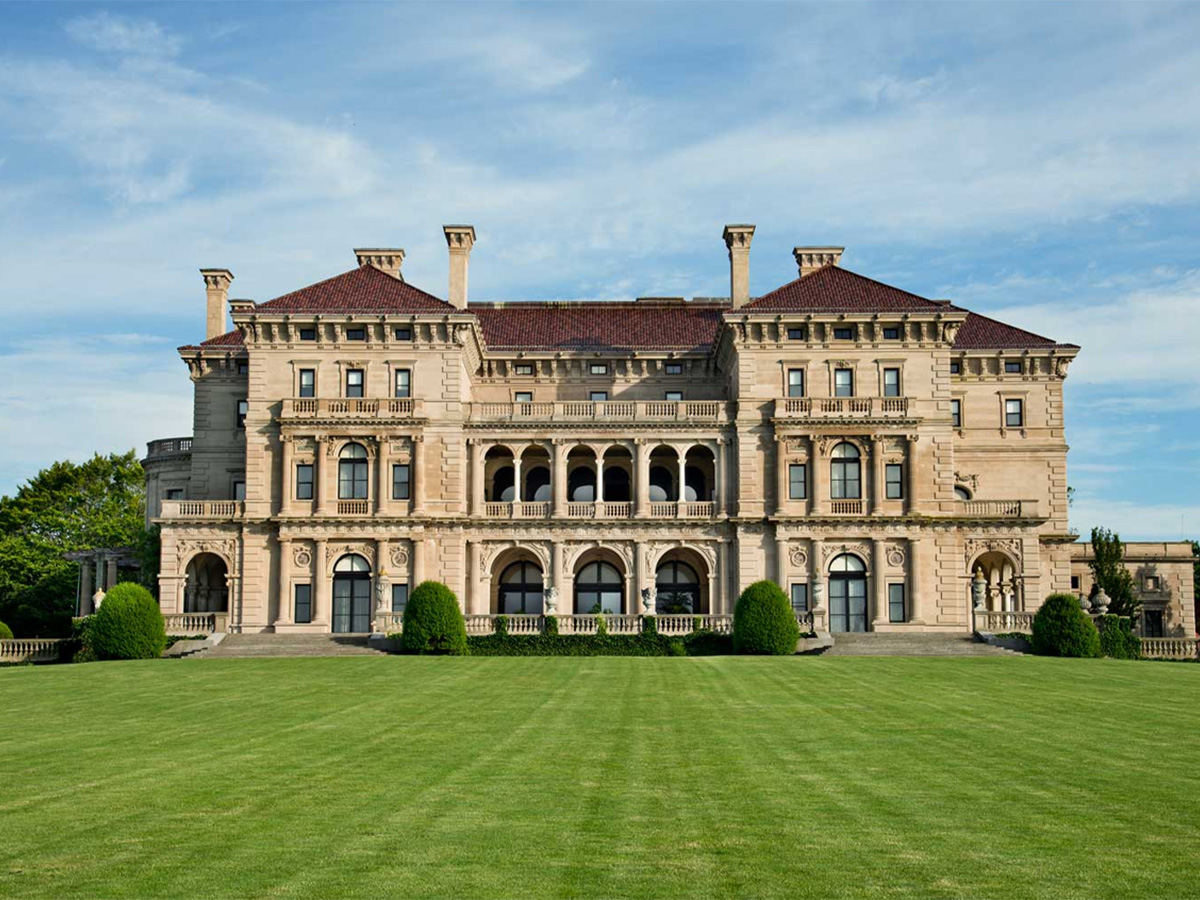
The Breakers (Corneilus Vanderbilt House) (Richard Morris Hunt, 1892-1895)
- “The Breakers”, it is arguably the grandest of Newport’s “summer cottages” and the second largest house in America.
- A classic Italian palazzo design, the finest American and European craftsmanship, views of the sea, and modern technology combined to make the ideal setting for luxurious living and entertaining.
- The new structure of steel, brick, and limestone kept the place fireproof, and the utilities such as the boilers were placed underground and away from the house.
- In keeping with the Italian Renaissance style, classical Roman influences are seen in the exterior columns and arches. The breathtaking central Great Hall, with its 50-foot-high ceiling, was inspired by the open-air courtyards of Italy but exudes the grandeur of the Gilded Age.
The Breakers was designated a National Historic Landmark on October 12th, 1994.
31 –Watts-Sherman House
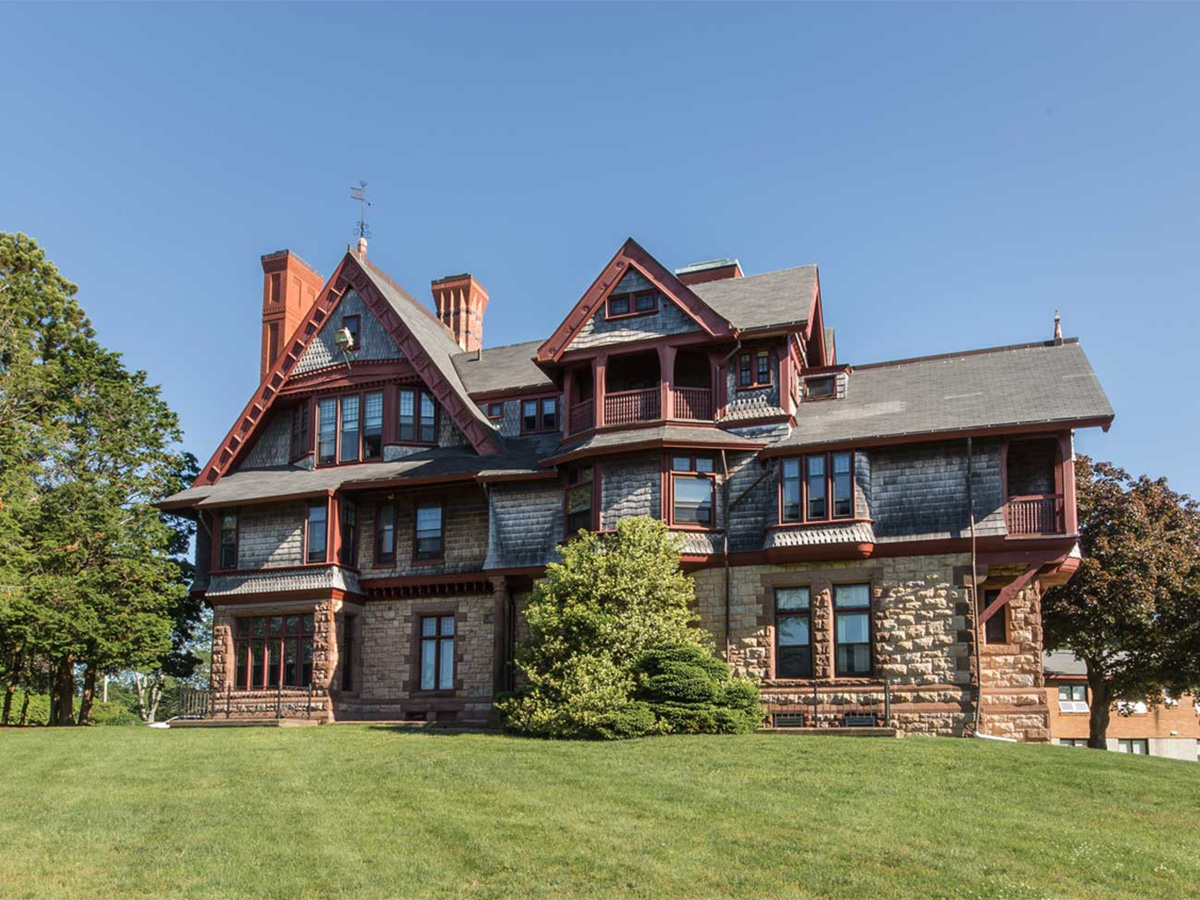
Watts-Sherman House (H.H. Richardson, 1881-1882)
- Officially a Queen Anne Style, but elements make it prototype for shingle style.
- English, German, and American Colonial influences, and features a rose garden that was moved to the property from the Fairholme estate.
- The original house was 2.5 stories in height and basically rectangular, with porte-cochere on the east facade, and two principal entrances on the west.
- Its first story was faced in pink granite ashlar, with higher stories of brick, shingle, and half-timbered stucco, diamond-panel windows grouped in long, horizontal bands, and five massive red brick chimneys. Trim materials included reddish sandstone and brownstone.
- The roof was steeply gabled, with a broad single gable in front and multiple sharp gables to the rear, all originally shingled in wood. Its interior organizes clusters of rooms about a spacious central stair hall.
Acquired by Salve Regina University in 1982 and now serves as a residence hall. It was designated a national historic landmark on December 30th, 1970.
32 – Chateau-sur-Mer

Chateau-Sur-Mer (Seth C. Bradford, Richard Morris Hunt, Ogden Codman Jr., 1852)
- Chateau-sur-Mer is an Italianate villa built for William Shepard Wetmore.
- It is regarded as a landmark of Victorian architecture, furniture, wallpaper, ceramics, and stenciling.
- The building was largely rebuilt by Richard Morris Hunt between 1872-1873, in the second empire style.
- Chateau-sur-Mer displays most of the major design trends of the last half of the 19th century.
- Chateau-sur-Mer was a villa because it was one of the few Newport “cottages” built as a year-round residence.
33 – President’s House

President’s House (Henry Hobson Richardson, 1896)
- The President’s House is home of the President of Salve.
- It was originally the carriage house for the William Watts Sherman House.
This house was inducted into the National Register of Historic Places on February 18th, 1989.
34 – Young Building

Young Building (Fairlawn) (Seth Bradford, Richard Morris Hunt, McKim, Mead & White, and Peabody & Sterns, 1852-3)
- The Young building is a Queen Anne Style mansion.
- It was originally Fairlawn for the Boston lawyer Andrew Ritchie and later owned by Levi. P Morton.
- The original design reflects Elizabethan style.
- The grouped chimney pots, masonry-trimmed brick walls, and original slate-patterned roof still show their English roots, It helps unify the cross block at the rear with front elevation having a curved porch.
- The triple gables of the house still echo the double, high-pitched gables originally derived from English Tudor architecture.
35 – Rosecliff
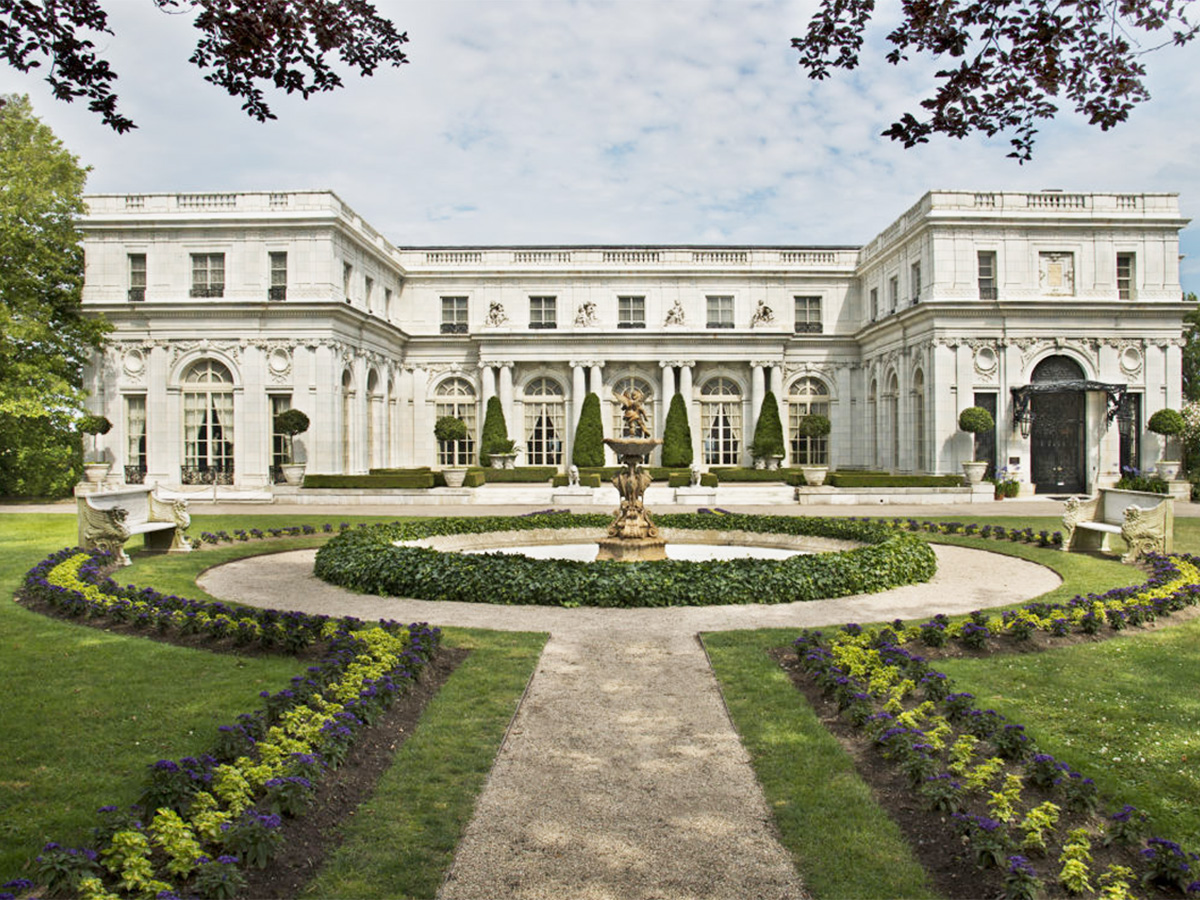
Rosecliff (Oehlrichs House) (McKim, Mead & White, 1899-1901
- Modeled after the Grand Trianon, the garden retreat of French kings at Versailles. It is smaller and reduced to a basic “H” shape, second story with a balustraded roofline that conceals the set-back third story.
- The brick construction is clad in white architectural terracotta tiles. Stanford White’s sophisticated spatial planning offered unexpected through aligned doorways centered on handsome monumental fireplaces with projecting overmantels. Its scheme of single and paired Corinthian pilasters alternating with arch-headed windows and recessed doorways echoes the articulation of the exterior.
- It could serve as Newport’s largest ballroom at 40 by 80 feet. Gilded Age summers filled with extravagant parties like the one featured in 1974’s The Great Gatsby, which filmed scenes at Rosecliff.
- The Stair Hall projects from the south block to accommodate a grand staircase that sweeps forward through a heart-shaped opening into the floor space. This divides at a landing to return in matched recurving flights to the upper floor.
- An amateur horticulturist, Bancroft grew thousands of roses at Rosecliff and his gardens along the Cliff Walk were famous.
This house was inducted into the National Register of Historic Places on February 6th, 1973.
36 – Beechwood
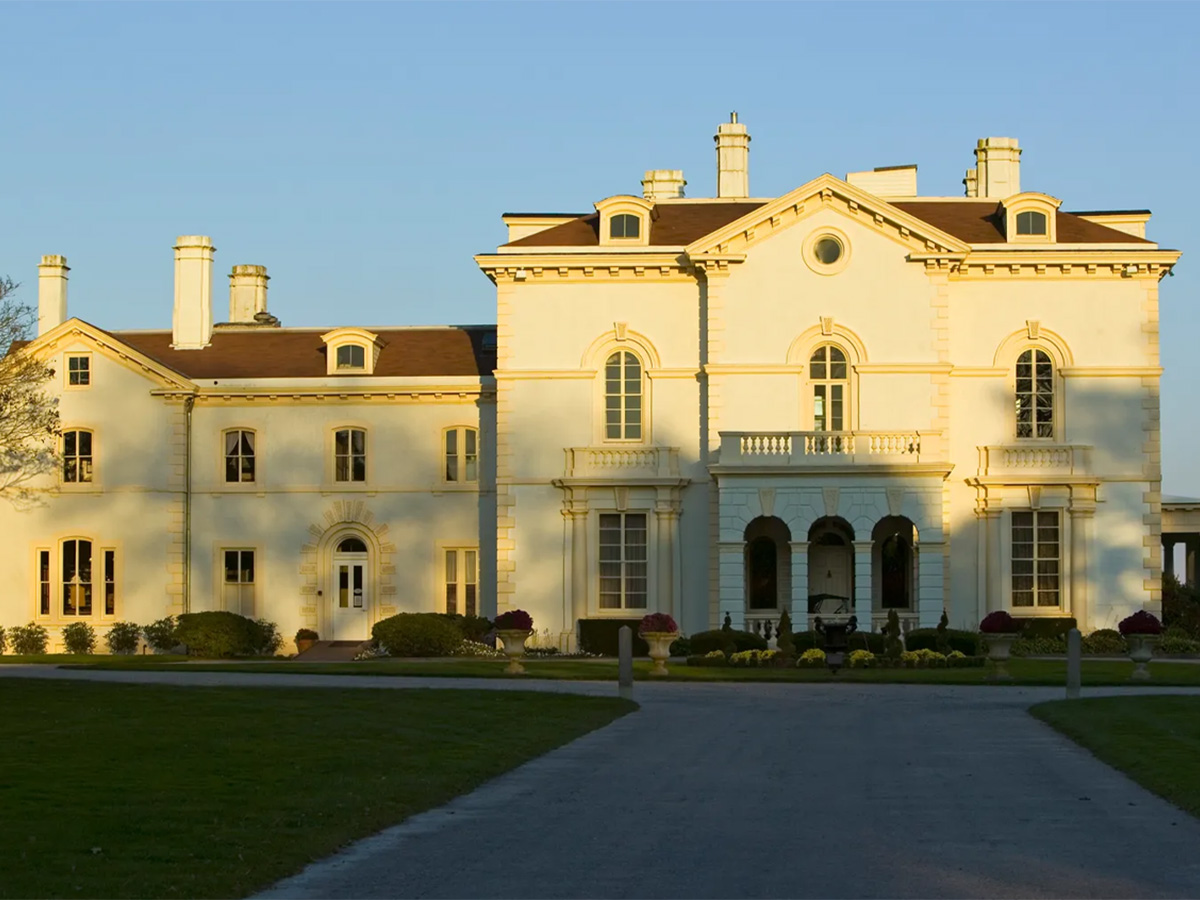
Beaulieu (Ruth’s World) (Calvert Vaux, 1859)
- Also known as “Astor Mansion” is a Gilded Age Mansion and estate.
- Beechwood can be described as a “Palatial Palace”.
- Beechwood is set amidst gardens, fountains and sculptures, set on a promontory surrounded by the ocean, it is the oldest of Newport’s cottages.
- Night and Day is reputed to have been written at the house by (Yalie) Cole Porter, while he was a guest at the house.
- It has been purchased and extensively renovated by Larry Elison.
37 – Marble House
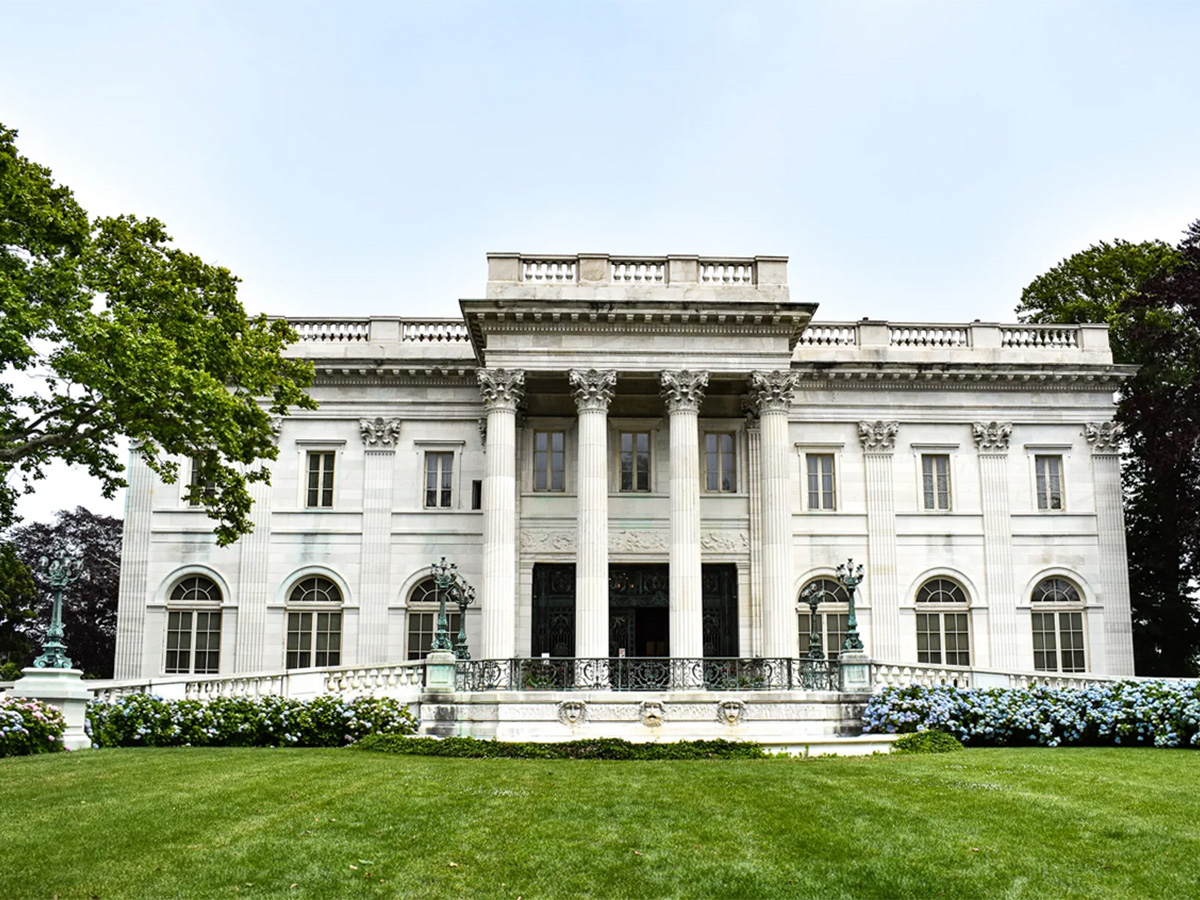
Marble House (Mrs. William K. Vanderbilt House) (Richard Morris Hunt, 1888-1892)
- A birthday present for Alva Smith Vanderbilt from her husband William K. Vanderbilt. A beaux Arts style. Its temple-front portico resembles that of the White House.
- Ochre Court was built to outshine the Petit Chateau in Manhattan, and in turn, the Vanderbilts built Marble House, also in Newport, to outshine Ochre Court. The cost of the house was reported in contemporary press accounts to be $11 million, of which $7 million was spent on 500,000 cubic feet of marble.
- The mansion is U-shaped and, while it appears to be two stories, it has four levels: the kitchen and other service areas are located in the basement; reception rooms are on the ground floor; bedrooms are on the second floor; and servant quarters are on the concealed third floor. Load-bearing walls are brick, with their exterior sides faced in white Westchester marble, which Hunt detailed in the manner of French neoclassical architecture of the seventeenth and eighteenth centuries.
- The facade of the mansion features bays that are defined by two story Corinthian pilasters. These framed arched windows on the ground floor and rectangular ones on the second occupy most of the facade.
- The Stair Hall is a two-story room that features walls and a grand staircase of yellow Siena marble, with a wrought iron and gilt bronze staircase railing.
- His wife later reopened Marble House and had a Chinese Tea House built on the seaside cliffs of the property, where she hosted rallies for women’s right to vote.
- The house was added to the National Register of Historic Places in 1971 and was designated a National Historic Landmark on February 17th, 2006.
38 – Beaulieu
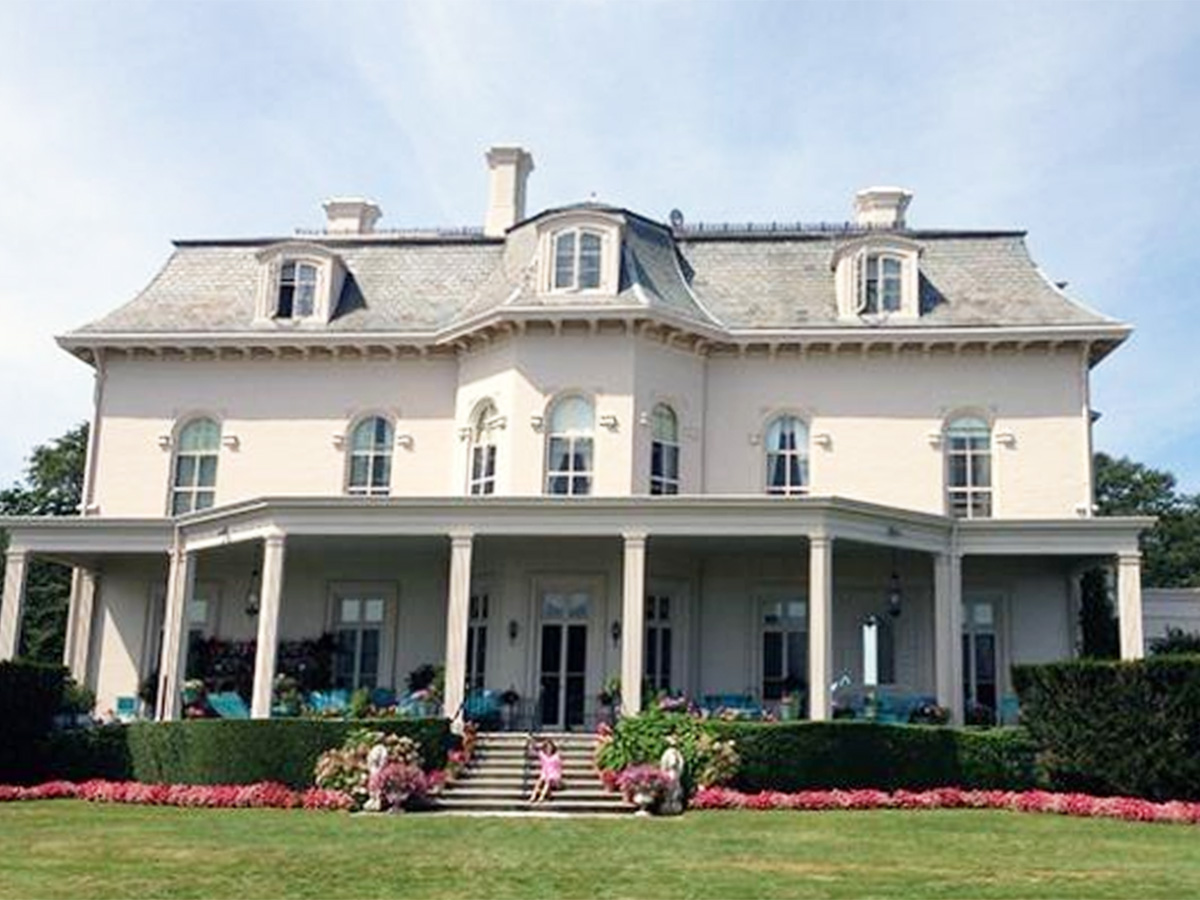
Beaulieu (Ruth’s World) (Calvert Vaux, 1859)
- One of Newport’s oldest mansions, Beaulieu was originally built in 1859 for the Peruvian merchant, Federico Barreda.
- Beaulieu is French for “Beautiful Place”
- This is still a private home without winter heat and is therefore used only in the summer.
39 – Clarendon Court
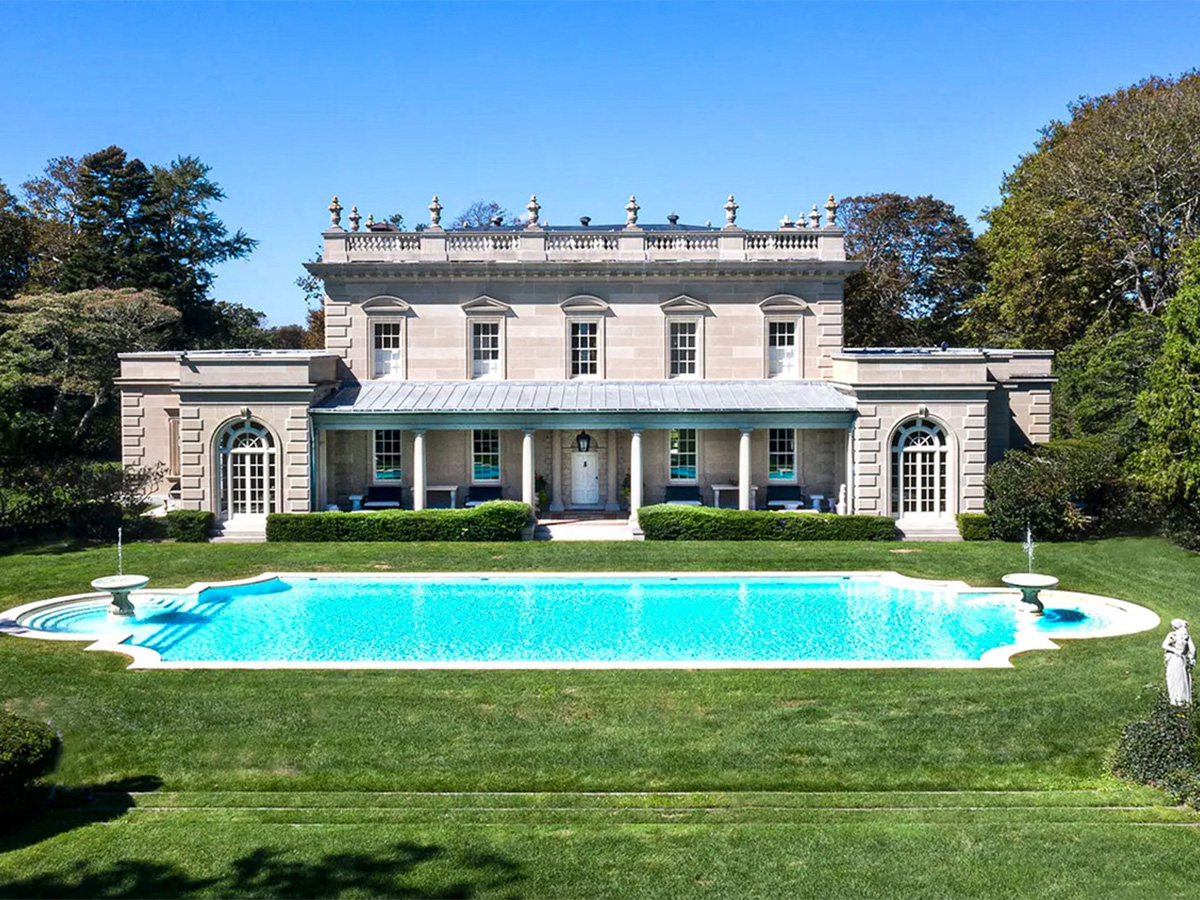
Clarendon Court (Horace Trumbauer, 1904)
- Designed by Philadelphia architect, Horace Trumbauer.
- The Newport “cottage,” named Clarendon after Clara Knight, the wife of Edward R. Knight, the Pennsylvania Railroad executive.
- In 1965, Clarendon Court served as a set for High Society starring Frank Sinatra, Bing Crosby and Grace Kelly.
- Clarendon is an identical replica of an early 18th century English mansion, “Hedworth House” at Chester-Le-Street in Durham.
- Adjacent to the main house — and equally impressive — is the 10,000-square-foot brick and limestone carriage house, designed in the English Baroque style. The carriage house is so elegant and well-proportioned that author Michael C. Kathrens deemed it, “without question one of Trumbauer’s more architecturally distinctive creations in this category.”
40 – Rovensky Park

Rovensky Park (1852)
- Rovensky Park is a historic park at the corner of Bellevue and Rovensky Ave.
- The park was donated by John E. Rovensky in memory of his wife, Mae Cadwell Rovensky. Their former house is across the street, Clarendon Court.
- The Aquidneck Land Trust recently received conservation easements on the park, ensuring that it will forever remain open space. Many of the trees within the park are labeled.
41 – Miramar
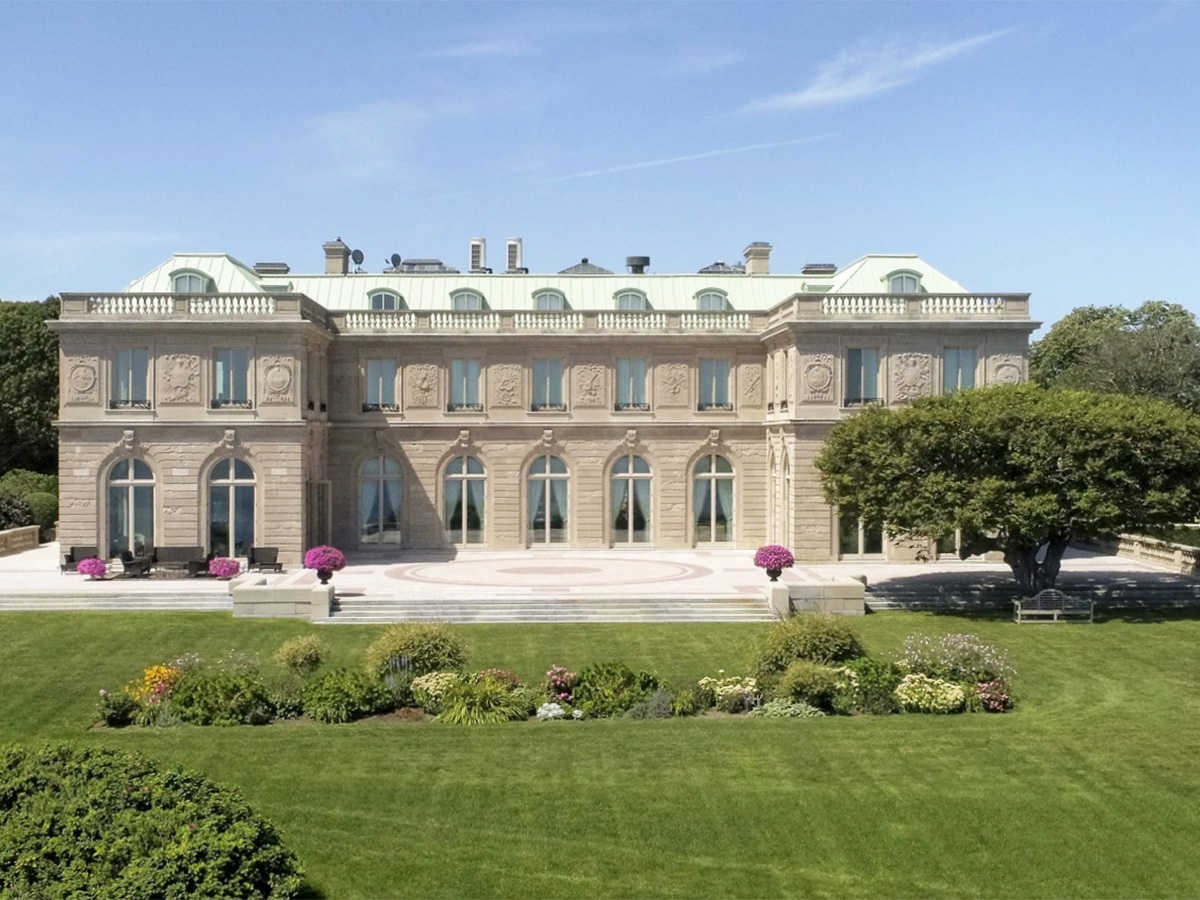
Miramar (Horace Trumbauer, 1914)
- The Miramar estate was completed in 1915 by a notable Titanic survivor Eleanor Widener as a memorial to her husband and son who were lost in the tragedy.
- Inspired by French neo-classicism and modeled after the 18th century Hotel de Cassini in Paris, the design was finalized, and construction began in 1913.
- The limestone manse’s 42 windows were shaded with awnings to prevent the precious tapestries from fading.
- Miramar’s grounds contain 8 acres of the French landscaper architect Jacques Greber, who laid out the grand parterre gardens facing Bellevue Avenue.
- Miramar is surrounded by a decorative fence with gated entry to the estate, statuary, fountains, two tennis courts and magnificent plantings grace the grounds.
- The Parisian firm of Carlhian & Cie executed the interiors.
42 – Ocean View
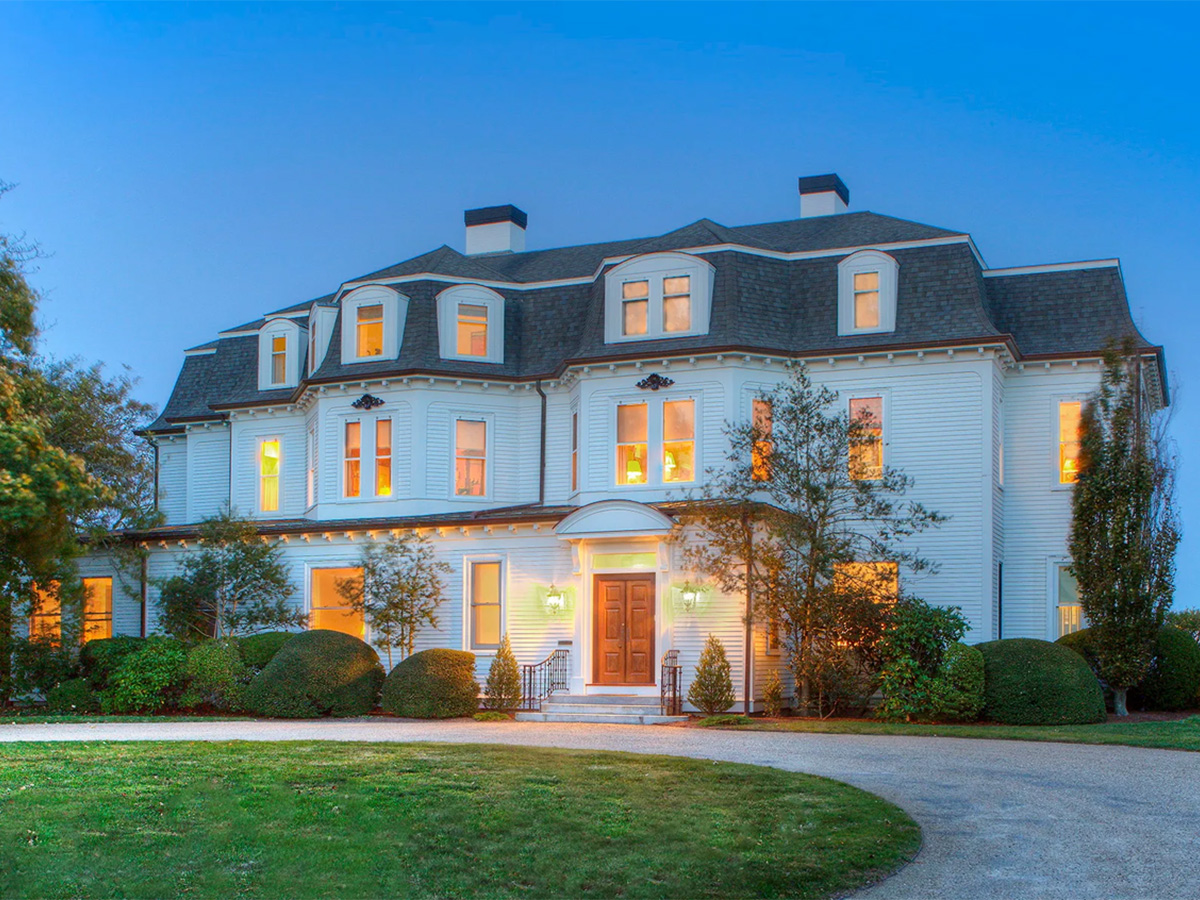
Ocean View (William Russell Walker, 1866)
- “Ocean View” was originally built in 1866 for William H. Reynolds in the Second Empire French style being the most popular Newport cottage in this era.
- This house is considered one of the most distinguished mansard-roofed homes built in the 1860s.
- Ocean view contains oversized floor to ceiling windows providing unparalleled light and panoramic views of the Atlantic Ocean.
- William Russell Walker designed this seaside cottage to capture the dramatic views of the coastline and the sea beyond.
43 – Rough Point
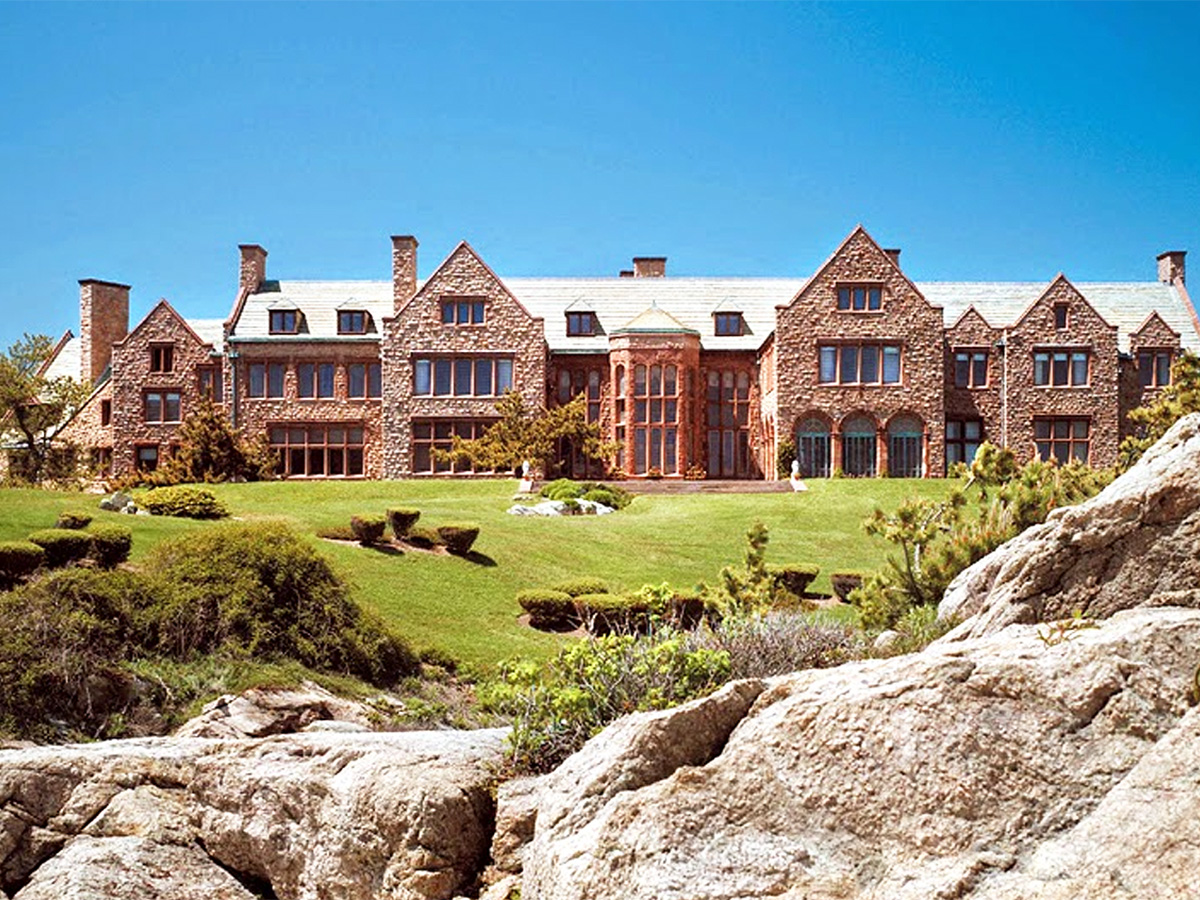
Fredrick William Vanderbilt House (Peabody & Sterns 1891 / Horace Trumbauer, 1922-23)
- Also known as “Rough Point”, it is an English Manorial style home built for the youngest of the Vanderbilt brothers.
- Now the Rough Point Museum, it was also the Newport home of heiress, collector, and philanthropist Doris Duke (1912-1993).
- Horizontal mass composed of stone walls with a small entry leading into a two-story English- style oak paneled hall that serves as spatial hub.
- The architectural significance of Rough Point can be attributed to Trumbauer’s ability to renovate and enlarge the original structure in a seamless manner.
- The original gardens were designed by Frederick Law Olmsted’s firm.
44 – Land’s End
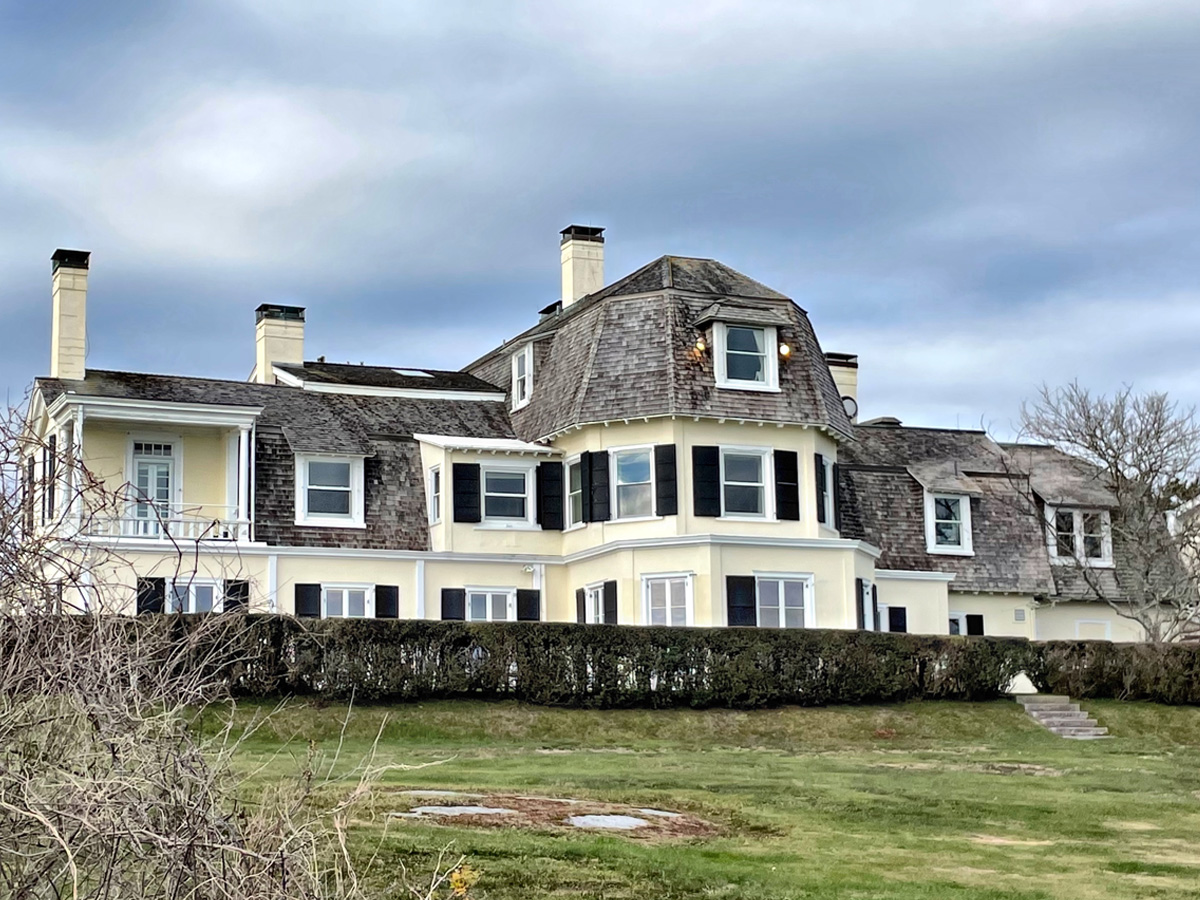
Land’s End (John Hubbard Sturgis, 1864)
- Built in 1864 for Boston banker, Samuel Gray Ward
- Built in the Second Empire Style, typical of that period.
- The residence of author, Edith Wharton, when she acquired the property in 1889
45 – The Waves

The Waves (John Russel Pope, 1927)
- Located on the southern-most projection of Aquidneck Island, a mile from Newport
- Built over the ruins of Governor Lippitt’s mansion
- Tudor style mansion, featuring stucco and stone siding, with a complex slate roof
- Materials matched the patina of the natural rock outcroppings
- One of the first homes to be converted into condo’s in the 1960’s.
Ross Cann, RA, AIA, LEED AP, is an author, historian, teacher and practicing architect living and working in Newport, RI. He holds degrees in Architecture and Architectural History from Yale, Cambridge, and Columbia Universities. He is a Leadership in Energy and Environmental Design Accredited Professional.
